
Chapter 2: Quadratic Functions
Lesson 1: Transformations of Quadratic Functions
Quadratic Functions
A quadratic function is a function that can be written in the form f(x) = a(x - h)2 + k, where a ≠ 0
The U-shaped graph of a quadratic function is called a parabola
Translations
Horizontal Translation
f(x) = x2
f(x - h) = (x - h)2
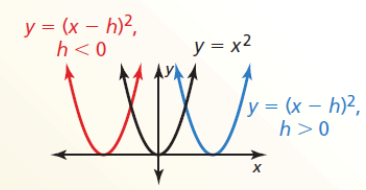
Shifts left when h < 0
Shifts right when h > 0
Vertical Translation
f(x) = x2
f(x) + k = x2 + k
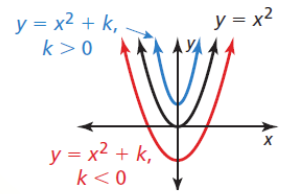
Shifts down when k < 0
Shifts up when k > 0
Reflections
Reflection in the x-axis
f(x) = x2
-f(x) = -(x2) = -x2
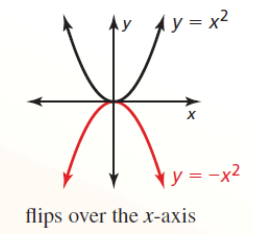
Reflection in the y-axis
f(x) = x2
f(-x) = (-x)2 = x2
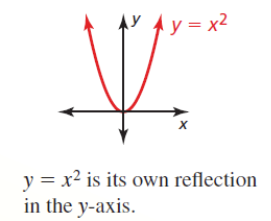
Stretches and Shrinks
Horizontal Stretches and Shrinks
f(x) = x2
f(ax) = (ax)2
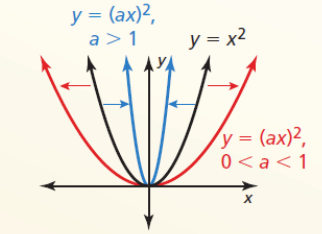
Horizontal stretch (away from y-axis) when 0 < a < 1
Horizontal shrink (towards y-axis) when a > 1
Vertical Stretches and Shrinks
f(x) = x2
a * f(x) = ax2
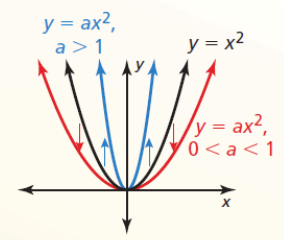
Vertical stretch (away from x-axis) when a > 1
Vertical shrink (towards x-axis) when 0 < a < 1
Vertex Form
The lowest part on a parabola that opens up or the highest point on a parabola that opens down is called the vertex
The vertex form of a quadratic function is f(x) = a(x - h)2 + k, where a ≠ 0 and the vertex is (h, k)
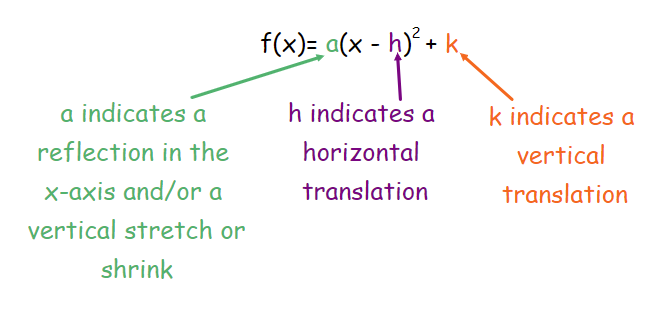
Lesson 2: Characteristics of Quadratic Functions
Quadratic Function Forms
Axis of Symmetry - a line that divides a parabola into mirror images and passes through the vertex; the axis of symmetry is the vertical line x = h or x = -b/2a
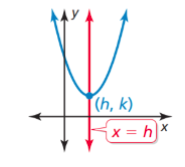
Standard Form - a quadratic function written in the form f(x) = ax2 + bx + c
Intercept Form - a quadratic function in the form f(x) = a(x - p)(x - q)
Properties of the Standard Form
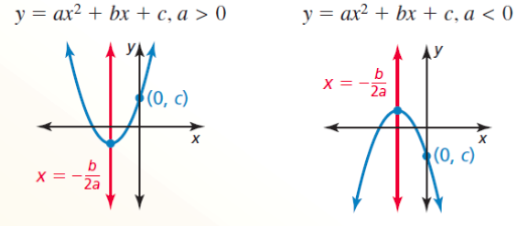
The parabola opens up when a > 0 and opens down when a < 0
The graph is narrower than the graph of f(x) = x2 when |a| > 1 and wider when |a| < 1
The axis of symmetry is x = -b/2a and the vertex is (-b/2a, f(-b/2a))
The y-intercept is c; the point (0, c) is on the parabola
Minimum and Maximum Values
For the quadratic function f(x) = ax2 + bx + c, the y-coordinate of the vertex is the minimum value of the function when a > 0 and the maximum value when a < 0

a > 0
Minimum value: f(-b/2a)
Domain: all real numbers
Range: y ≥ f(-b/2a)
Decreasing to the left of x = -b/2a
Increasing to the right of x = -b/2a
a < 0
Maximum value: f(-b/2a)
Domain: all real numbers
Range: y ≤ f(-b/2a)
Increasing to the left of x = -b/2a
Decreasing to the right of x = -b/2a
Properties of the Intercept Form
Because f(p) = 0 and f(q) = 0, p and q are the x-intercepts of the graph of the function
The axis of symmetry is halfway between (p, 0) and (q, 0); x = (p + q)/2
The parabola opens up when a > 0 and opens down when a < 0

Lesson 3: Modeling with Quadratic Equations
Writing Quadratic Equations
Given a point and the vertex (h, k), use vertex form: y = a(x - h)2 + k
Given a point and x-intercepts p and q, use intercept form y = a(x - p)(x - q)
Given three points, write and solve a system of three equations in three variables
Chapter 2: Quadratic Functions
Lesson 1: Transformations of Quadratic Functions
Quadratic Functions
A quadratic function is a function that can be written in the form f(x) = a(x - h)2 + k, where a ≠ 0
The U-shaped graph of a quadratic function is called a parabola
Translations
Horizontal Translation
f(x) = x2
f(x - h) = (x - h)2

Shifts left when h < 0
Shifts right when h > 0
Vertical Translation
f(x) = x2
f(x) + k = x2 + k

Shifts down when k < 0
Shifts up when k > 0
Reflections
Reflection in the x-axis
f(x) = x2
-f(x) = -(x2) = -x2

Reflection in the y-axis
f(x) = x2
f(-x) = (-x)2 = x2

Stretches and Shrinks
Horizontal Stretches and Shrinks
f(x) = x2
f(ax) = (ax)2

Horizontal stretch (away from y-axis) when 0 < a < 1
Horizontal shrink (towards y-axis) when a > 1
Vertical Stretches and Shrinks
f(x) = x2
a * f(x) = ax2

Vertical stretch (away from x-axis) when a > 1
Vertical shrink (towards x-axis) when 0 < a < 1
Vertex Form
The lowest part on a parabola that opens up or the highest point on a parabola that opens down is called the vertex
The vertex form of a quadratic function is f(x) = a(x - h)2 + k, where a ≠ 0 and the vertex is (h, k)

Lesson 2: Characteristics of Quadratic Functions
Quadratic Function Forms
Axis of Symmetry - a line that divides a parabola into mirror images and passes through the vertex; the axis of symmetry is the vertical line x = h or x = -b/2a

Standard Form - a quadratic function written in the form f(x) = ax2 + bx + c
Intercept Form - a quadratic function in the form f(x) = a(x - p)(x - q)
Properties of the Standard Form

The parabola opens up when a > 0 and opens down when a < 0
The graph is narrower than the graph of f(x) = x2 when |a| > 1 and wider when |a| < 1
The axis of symmetry is x = -b/2a and the vertex is (-b/2a, f(-b/2a))
The y-intercept is c; the point (0, c) is on the parabola
Minimum and Maximum Values
For the quadratic function f(x) = ax2 + bx + c, the y-coordinate of the vertex is the minimum value of the function when a > 0 and the maximum value when a < 0

a > 0
Minimum value: f(-b/2a)
Domain: all real numbers
Range: y ≥ f(-b/2a)
Decreasing to the left of x = -b/2a
Increasing to the right of x = -b/2a
a < 0
Maximum value: f(-b/2a)
Domain: all real numbers
Range: y ≤ f(-b/2a)
Increasing to the left of x = -b/2a
Decreasing to the right of x = -b/2a
Properties of the Intercept Form
Because f(p) = 0 and f(q) = 0, p and q are the x-intercepts of the graph of the function
The axis of symmetry is halfway between (p, 0) and (q, 0); x = (p + q)/2
The parabola opens up when a > 0 and opens down when a < 0

Lesson 3: Modeling with Quadratic Equations
Writing Quadratic Equations
Given a point and the vertex (h, k), use vertex form: y = a(x - h)2 + k
Given a point and x-intercepts p and q, use intercept form y = a(x - p)(x - q)
Given three points, write and solve a system of three equations in three variables
 Knowt
Knowt
